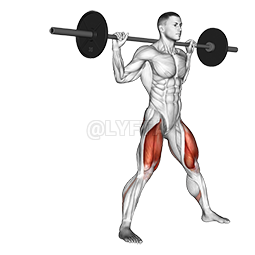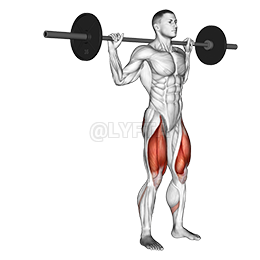
Barbell Full Squat
Exercise Profile
Related Exercises:
Introduction to the Barbell Full Squat
The Barbell Full Squat is a comprehensive strength training exercise that primarily targets the quadriceps, hamstrings, and glutes, while also engaging the core and lower back. It is suitable for everyone from beginners to advanced athletes, as it can be customized to individual fitness levels and goals. This exercise is beneficial for those who want to build lower body strength, improve mobility, and enhance overall athletic performance.
Performing the: A Step-by-Step Tutorial Barbell Full Squat
- Stand facing the barbell, spread your feet shoulder-width apart, and duck under the bar to position it on the back of your shoulders, just below the neck.
- Firmly grasp the barbell with both hands, lift it off the rack by straightening your legs, and take a step or two back to position yourself.
- Slowly bend your knees and lower your body as if you're sitting back into a chair, keeping your back straight and chest up until your thighs are parallel with the floor.
- Push through your heels to return to the standing position, ensuring that your knees are not locked at the top, and repeat the exercise as many times as needed.
Tips for Performing Barbell Full Squat
- Proper Bar Placement: The barbell should rest on the upper part of your back, not on your neck. It should be held with a grip that is just wider than shoulder-width. This position helps to avoid unnecessary strain on your neck and shoulders.
- Maintain Neutral Spine: It's essential to maintain a neutral spine throughout the exercise. Avoid rounding your back or excessively arching it. This common mistake can lead to serious back injuries. Engage your core and keep your chest up to help maintain this position.
- Depth of the Squat: Aim to lower your body until your hips are below your knees. This is a full squat. Half squats or quarter squats are common mistakes and do not engage the
Barbell Full Squat FAQs
Can beginners do the Barbell Full Squat?
Yes, beginners can do the Barbell Full Squat exercise, but it's important to start with lighter weights and focus on proper form to avoid injury. It's also helpful to have a trainer or experienced gym-goer assist or guide you initially. As you gain strength and confidence, you can gradually increase the weight.
What are common variations of the Barbell Full Squat?
- Box Squat: In this variation, you squat down until your glutes touch a box or bench behind you, which helps to perfect form and depth.
- Overhead Squat: This challenging variation involves holding the barbell overhead throughout the entire movement, engaging not only your lower body, but also your shoulders, arms, and core.
- Zercher Squat: This squat involves holding the barbell in the crook of your elbows, increasing the difficulty and engaging your biceps and forearms.
- Goblet Squat: Although typically performed with a kettlebell or dumbbell, this squat can also be done with a barbell held vertically against your chest, promoting good form and depth.
What are good complementing exercises for the Barbell Full Squat?
- Lunges, another related exercise, can enhance the benefits of Barbell Full Squat by working each leg individually, which can help correct muscle imbalances and improve stability, both essential for performing squats safely and effectively.
- Deadlifts can complement Barbell Full Squats by strengthening the lower back, hamstrings and glutes, which are crucial for maintaining good form during squats and to avoid injury, while also improving overall body strength and power.
Related keywords for Barbell Full Squat
- Barbell Squat Workout
- Quadriceps Strengthening Exercise
- Thigh Toning with Barbell
- Full Squat Routine
- Barbell Exercise for Legs
- Heavy Squat Workout
- Quadriceps Barbell Squat
- Thigh Building Exercise
- Full Barbell Squat Technique
- Quadriceps and Thighs Workout with Barbell










